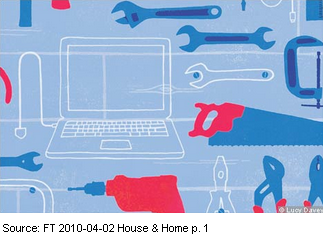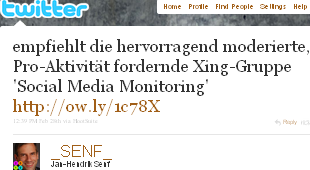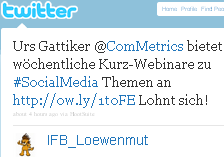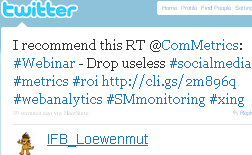The first step is simple: start monitoring numbers that measure something and draw the right conclusions. For instance, when the temperature reaches 35 degrees Celsius, air conditioning helps office productivity, making it a mediating factor for, though not a cause of, your Return on Investment (ROI).
Similar reasoning applies to social media measurement. We have addressed some of these issues previously:
In this post we focus on measuring smarter, while ensuring that we correctly work out the statistical pattern and address five critical pointers for establishing a successful monitoring program.
Assume nothing, question everything.
Qualitative and quantitative measures
We love to use quantitative measures because these are easy to acquire. Often, traditional measuring follows a script similar to this:
- a) Number of unique visitors from each source (e.g., search engines, referrals, direct visitors),
b) Size of network (‘likes’ on Facebook formerly called fans, subscribers, Twitter followers), and
c) Quantity and quality of commentary about brand or product (of limited importance for SMEs, but crucial for big names like Nespresso and Perrier).
However, the above data is usually biased (e.g., a unique visitor is not necessarily unique), or the pattern we discover is incorrectly attributed to a cause.
So while collecting quantitative data saves time and is relatively easy, as Aldo Gnocchi points out, qualitative assessments are critical but difficult to do systematically without using huge resources, such as time to analyze how engaging comments really are.
Metrics that make sense
Qualitative and quantitative data, as well as a combination thereof all help improve performance. Most importantly, we must be clear on how we intend to measure our social media efforts. More often than not, numbers do not convince those holding the purse strings.
- 1. What do you want to achieve with social media activity?
If you are a small business, building reputation (i.e. what others think about you, your product, etc.) is all there is, since the cash available hardly enables building a global brand.
Social media is not for selling, but staying in touch with and keeping your current clients engaged, while connecting to potential new ones.
- 2. What social media activity are you trying to measure and assess?
 It is obvious that different social media channels (e.g., corporate blogging, micro-blogging, participating in social networks) require different methods to measure your efficiency.
It is obvious that different social media channels (e.g., corporate blogging, micro-blogging, participating in social networks) require different methods to measure your efficiency.
In fact, you may not want to use certain tools to engage clients, but to gain intelligence, learn and build a reputation as an expert (e.g., Twitter).
This is in contrast to corporate blogs, which focus best on serving clients’ needs for information and tools.
- 3. How much is enough?
In the same way that making a quiche or soufflé does not make you a chef, surfing the web does not make you an expert on social media measurement. You may need advice to set things up properly in order to:
- a) Require no more than 10 minutes to get the info you need daily, and
b) Spend an optimal amount of money for your situation (e.g., subscribe to the Freemium version or 30-day trial and check data weekly at My.ComMetrics.com).
Figuring out what data are used for are the next critical steps (see points 4 and 5 below).
- 4. We’ve got data – now what?
Once we have collected data, we need to focus on:
- a) Watching the trends, and
b) Comparing our performance to benchmarks (e.g., best in class, competitors).
Whichever competitor keeps your boss awake at night is a good place to start for comparison.
- 5. How can we get actionable metrics?
Noticing that crops grow under trees is fine, but concluding that bird droppings increase yields may be incorrect. The challenge is to work out whether a statistical pattern is caused by what we think it has. For instance, a regression analysis can demonstrate correlation (the two variables just happen to move together), but it cannot tell you whether sales increase because of A/B testing (i.e. causality).
One can use what economists call an ‘instrumental variable’ (also sometimes called a moderator or mediating variable), which is some outside force that partly mimics the effect of a properly randomized trial.
Another technique is to look for sudden jumps in variables that have nothing to do with the matter at hand (see Angrist and Pischke, 2010).
The challenge is two-fold: making sure the boss can follow your statistical explanations (not an easy task if you have to explain what an instrumental variable is), and ensuring you don’t confuse causality with correlation.
Thereafter, data have to be interpreted correctly and the right decisions must be made, such as:
- a) What can we do with the data and metrics to improve performance? Should we (e.g., get more pageviews)?
b) If we are over or under budget (e.g., pageviews) what caused this result AND how can we further improve and/or achieve our goals?
Just collecting metrics and feeling good about them is not useful because this makes them vanity metrics. What matters most are the insights data can provide and our actions to improve our performance as a result.
Take-aways
Telling a manager that the company got ’10 favorable tweets’ or ‘5 positive comments on Facebook’ is nowhere near as valuable as the single tweet that recommends a specific action to others (see right).
Besides, we look for:
- – baseline measurement: establish a baseline so you know where you are starting from.
– annual audits: why did some blog posts, tweets or ad campaigns work while others failed, and can successes be repeated?
– trend monitoring: watch trends and make comparisons with past results (e.g., April 2010 with April 2009), while taking the necessary actions to improve.
In order to properly measure your baseline and complete future audits that will yield good information, Key Performance Indicators (KPIs) must be agreed upon right away, and you must always verify references and data to ensure they are what they seem.
Beware potential fallacies in data, as pointed out by Tim Gier: “I think, though, that often the results that we can measure cause us to chase after goals that are actually at cross purposes with long term success, goals which are not worth having.”
Finally, let us not forget that learning about metrics and putting an effective measurement system in place is a process, not an event.
More resources
- Marketing Sherpa – What social metrics are organizations monitoring and measuring? => Not a representative sample but interesting.
Social Times – The 10 social media metrics your company should monitor
ComMetrics – Sentiment analysis for online content: Honest?
ClickZ – After a sour start in social media, skittles gets sweet results => Giving away discount vouchers and free product helps now, but does it help in the long term as well?
Angrist, J. & Pischke J.-S. (March 2010) – The credibility revolution in empirical economics: How better research design is taking the con out of econometrics. Discussion Paper Series No. 4800. Bonn, Germany: IZA
What is your take? What measures have you taken to arrive at actionable metrics that help your organization improve its social media effectiveness? Are you planning any new measures? Are there metrics you measure that we did not mention that you feel are more important for your organization? Please let us know in the comments!
You can get updates for this blog on Twitter by following @ComMetrics, get a free subscription by RSS, or get new posts via email:
Article source: ComMetrics – Social media metrics: 5 critical steps to success
ComMetrics University – coffee break webinars
 Webinars are held every Wednesday at 8:45 AM CET for no more than 20 minutes – the time you spend on a coffee break. In order to make each webinar as interactive as possible, we will limit attendance to about 15 people, so please register yourself NOW, since space is limited and filled on a first-come, first-served basis.
Webinars are held every Wednesday at 8:45 AM CET for no more than 20 minutes – the time you spend on a coffee break. In order to make each webinar as interactive as possible, we will limit attendance to about 15 people, so please register yourself NOW, since space is limited and filled on a first-come, first-served basis.
Our inaugural webinar was held last week. Today we have:
 2010-04-07 ComMetrics University – coffee break webinar: Social media metrics: 5 steps to increase productivity
2010-04-07 ComMetrics University – coffee break webinar: Social media metrics: 5 steps to increase productivity
Or just leave a comment below and we will make sure that you get a personal invitation with the particulars for next week’s webinar, including presentation slides that include links to further resources and freebies.
Pingback: World Economic Forum
Pingback: Urs E. Gattiker
Pingback: Annalie Killian
Pingback: wilko64
Pingback: Marina S Feehan
Pingback: Nils Montan
Pingback: Nils Montan
Pingback: Mary Cruse
Pingback: Gaurang Trivedi SEO
Pingback: Alex Hall
Pingback: Alex Hall
Pingback: MyCrowd.ca
Pingback: fury